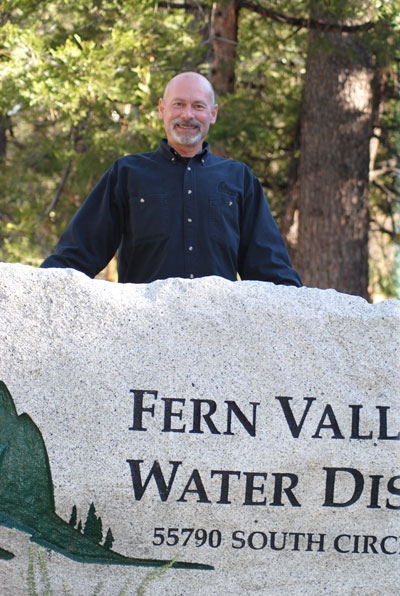
Photo by JP Crumrine
Steve Erler, general manager of Fern Valley Water District, announced his intention to retire at the end of June 2016. The board was surprised, shocked, and saddened to learn of Erler’s plans, which he shared at the end of the Dec. 18 meeting.
Erler has served as general manager a little more than 18 years, since his appointment in November 1997.
At the end of the meeting, Erler told the board he was planning a fishing trip with his brother and father, who will turn 80 soon, at the end of the fiscal year; but “I’m not coming back,” he added with a smile and tear.
“It has been an honor and privilege to serve as Fern Valley Water District’s general manager,” he wrote in his resignation letter. “I am extremely proud of our accomplishments and thankful for the support and opportunities the Board of Directors has given me during my time here.”
“I’m in shock, but happy for Steve,” said Jim Rees, board vice president in the absence of President Robert Krieger. “I’m happy for you, but we have big shoes to fill.”
Director Richard Schnetzer noted that Erler planned to continue through June 30 and said, “We have a lot of months to convince you to change your mind.”
At the January meeting, when the board will elect officers for 2016 and organize committees, it plans to establish a committee to recruit a new general manager, according to Rees.
Earlier in the meeting, the board accepted the audit of its 2014-15 finances. Teaman, Ramirez and Smith of Riverside performed the audit. They found the financial statement disclosure “neutral, consistent and clear” and opined that they were presented fairly and in accordance with general accounting principals used. They encountered no significant difficulties in dealing with management while performing the audit.
Teaman made three recommendations, two of which were establishing policies for purchasing and capitalization of assets greater than a specific dollar threshold, such as $1,000. The third recommendation addressed segregating some financial duties, but the auditors recognized that the small size of the staff was a significant limitation on implementing this recommendation.
For fiscal year 2014-15, the district’s revenues were nearly $110,000 greater than its expenditures. The net position of the district is $7.4 million, of which nearly 86 percent is capital assets with cash of about $1.6 million.
FVWD’s largest liabilities are pensions and post-employment benefits such as health care. These total about $400,000. The district also owes about $255,000 on the note for the for the Saunders Meadow capital improvements. It is due in 2037.
In water business, Erler reported that the groundwater levels of many of the district’s wells had risen slightly in November, but remain below their 2014 levels.
He also announced that water production in 2015 was 32 percent less than in 2013. The State Water Resources Control Board had set a goal of 25-percent reduction in consumption for all California water districts.
“In my view, this is fantastic,” Erler said. “It exceeds the 25-percent goal.” He attributed the customer compliance with Stage 3 water conservation. “While [water] didn’t go up, our revenues were down,” he added.
“Those using water regularly were doing so with greater consciousness,” commented Schnetzer.










